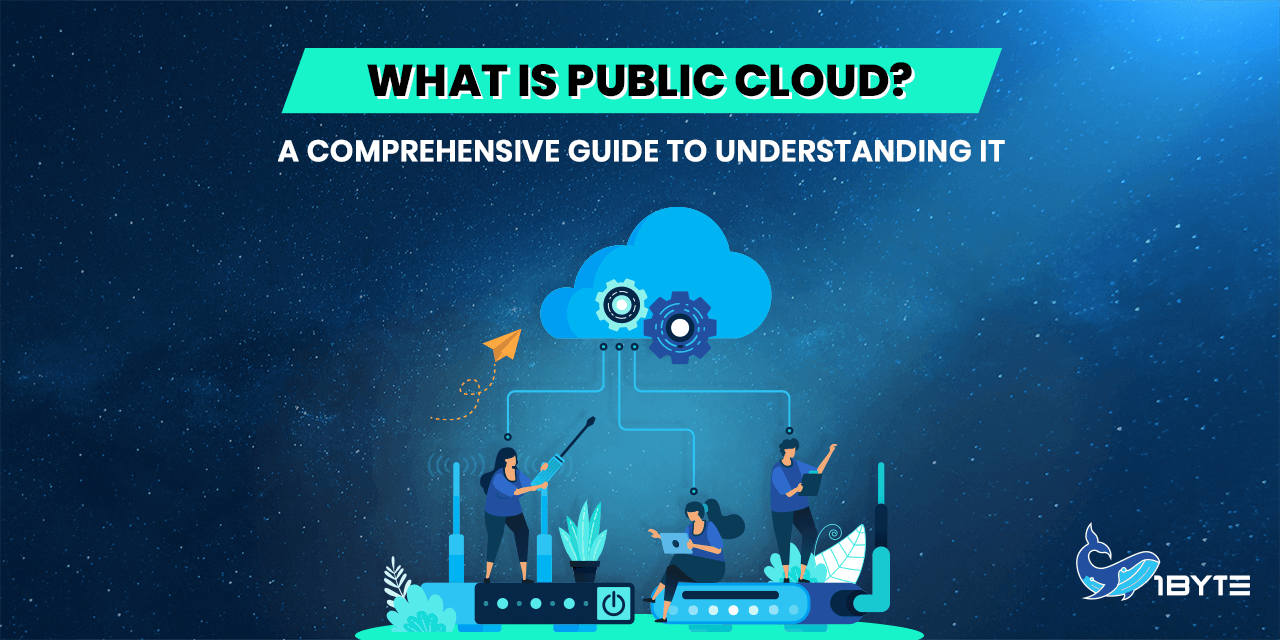The public cloud has become a ubiquitous term in the world of technology, but what exactly is it? In simple terms, public cloud is a type of cloud computing where computing resources, such as infrastructure, platforms, and software, are made available to the public over the internet.
This article from 1Byte aims to provide a comprehensive guide to understanding the public cloud, its key characteristics, advantages, types, and providers. The purpose of it is to educate individuals and organizations on what the public cloud is, how it works, and why it has become a popular choice for leveraging the benefits of cloud computing.
By the end of this article, you will have a clear understanding of the public cloud, its capabilities, and how it can benefit your organization. So, whether you’re new to the world of cloud computing or looking to expand your knowledge, this comprehensive guide to understanding the public cloud is for you.
What Is Public Cloud?
Public cloud is a cloud computing model where resources, such as infrastructure, platforms, and software, are made available to the public over the internet. It enables individuals and organizations to access computing resources on demand, without having to manage and maintain physical infrastructure.
The public cloud is different from private and hybrid clouds, which are dedicated to specific organizations or a combination of public and private resources. In comparison, public clouds are shared among multiple organizations and customers, making them cost-effective and scalable.
Differences Between Private and Hybrid Clouds:
Public cloud is different from private and hybrid clouds, which are also forms of cloud computing. Understanding the differences between the three is crucial for determining the best fit for your organization’s needs.

Private Cloud
A private cloud is a cloud computing model where computing resources are dedicated to a single organization and are not shared with others. Private clouds are typically maintained and managed by the organization itself or by a third-party provider on behalf of the organization. Private clouds provide organizations with greater control and customization over their computing resources, but they also require a significant investment in infrastructure and management.
Hybrid Cloud
A hybrid cloud is a combination of both public and private clouds, where some resources are hosted on the public cloud, and others are hosted on a private cloud. This provides organizations with the benefits of both worlds, allowing them to take advantage of the scalability and cost-effectiveness of the public cloud while still maintaining control and security over critical resources through a private cloud.
In comparison, public clouds are shared among multiple organizations and customers, making it cost-effective and scalable. However, public clouds do not provide the same level of control and customization as private clouds, and organizations must rely on the security measures put in place by the public cloud provider.
The choice between public, private, and hybrid clouds depends on the specific needs and requirements of an organization. Public clouds are ideal for organizations looking for cost-effective and scalable computing resources, while private clouds provide greater control and customization. Hybrid clouds offer the best of both worlds, allowing organizations to balance cost-effectiveness, scalability, and control.
The Key Characteristics of Public Cloud
Public clouds are characterized by several key features that set them apart from other forms of cloud computing. These characteristics are what make public clouds an attractive option for organizations looking to leverage the benefits of cloud computing.
1. On-demand and scalable: Public clouds provide computing resources on-demand, allowing organizations to scale up or down as needed. This is particularly beneficial for organizations that experience fluctuations in demand for computing resources.
2. Multi-tenant: Public clouds are shared among multiple organizations and customers, making them cost-effective and efficient. This also allows organizations to take advantage of the economies of scale achieved by the cloud provider.
3. Pay-as-you-go pricing: Public clouds typically use a pay-as-you-go pricing model, where organizations only pay for the resources they use. This is a cost-effective alternative to traditional IT infrastructure, where organizations must make a large upfront investment in hardware and software.
4. Accessible over the internet: Public clouds can be accessed from anywhere with an internet connection, making them highly accessible and convenient for organizations with remote workers or a dispersed workforce.
5. Managed by the provider: Public clouds are managed by the provider, freeing up organizations from the burden of managing and maintaining their own IT infrastructure. This allows organizations to focus on their core business functions, rather than worrying about the technical details of their computing resources.
Use Cases of Public Cloud
Public clouds have a wide range of use cases, making them suitable for organizations of all sizes and industries. Some of the most common use cases for public clouds include:
1. Web and mobile application hosting: Public clouds are well-suited for hosting web and mobile applications, providing organizations with the scalability and availability they need to support high levels of traffic and usage.
2. Big data analytics: Public clouds provide organizations with the computing power and storage capacity they need to process and analyze large amounts of data, making them ideal for big data analytics.
3. Disaster recovery: Public clouds provide organizations with a cost-effective way to implement disaster recovery, ensuring that their critical data and applications are protected in the event of an outage or disaster.
4. Software as a Service (SaaS): Public clouds are the foundation for many SaaS applications, providing organizations with access to software over the internet, and eliminating the need for hardware and software installations.
5. DevOps: Public clouds are widely used for DevOps, providing organizations with the flexibility and scalability they need to quickly test and deploy new software applications.
6. Infrastructure as a Service (IaaS): Public clouds provide organizations with the computing, storage, and network resources they need to run their IT infrastructure, making them ideal for IaaS.
These are just a few examples of the many use cases for public clouds. With their cost-effectiveness, scalability, and ease of use, public clouds are an attractive option for organizations looking to take advantage of the benefits of cloud computing.
5 Advantages of Public Cloud
One of the key reasons that organizations choose public clouds is the numerous advantages they offer. From cost-effectiveness to scalability, public clouds provide organizations with a range of benefits that help them achieve their goals and succeed in today’s fast-paced business environment.

In this section, we will explore the key advantages of public clouds, including cost savings, scalability, accessibility, and ease of use. Whether you are just starting out with cloud computing or are looking to expand your existing cloud footprint, this section will help you understand the many benefits of public clouds and how they can help your organization succeed.
1. Cost Saving
One of the primary benefits of public clouds is the cost savings they offer. By leveraging the shared infrastructure and economies of scale provided by cloud providers, organizations are able to reduce their capital expenditures and operational expenses associated with IT.
1. Reduced Capital Expenditures: Public clouds eliminate the need for organizations to purchase and maintain their own hardware and software, which can be expensive and time-consuming. By using public clouds, organizations can take advantage of the shared infrastructure provided by cloud providers, reducing their capital expenditures and freeing up resources to invest in other areas of their business.
2. Lower Operational Expenses: In addition to reducing capital expenditures, public clouds also offer lower operating expenses compared to traditional IT infrastructures. With public clouds, organizations no longer have to manage and maintain their own hardware and software, which can be labor-intensive and expensive. Cloud providers handle these tasks, which reduces the operational expenses associated with IT and frees up resources for other initiatives.
3. Pay for Only What You Need: With public clouds, organizations only pay for the computing resources they actually use. This provides organizations with greater flexibility and control over their IT costs, as they can easily scale their infrastructure up or down as needed. Furthermore, public clouds offer a range of pricing options, including pay-as-you-go and reserved instances, which can further reduce costs and help organizations control their IT expenses.
In conclusion, the cost savings offered by public clouds are one of their key benefits, providing organizations with a more cost-effective way to run their IT infrastructure. By reducing capital expenditures, lowering operational expenses, and providing greater control over IT costs, public clouds offer organizations a range of benefits that help them achieve their goals and succeed in today’s fast-paced business environment.
2. Scalability
Public clouds provide organizations with the ability to quickly and easily scale their IT infrastructure up or down as needed, allowing them to respond to changing demands and business requirements.
1. On-Demand Resources: Public clouds offer organizations the ability to access a wide range of computing resources on demand, including storage, processing power, and memory. This means that organizations can quickly and easily add or remove resources as needed, without having to purchase or maintain additional hardware or software.
2. Efficient Scaling: Public clouds are designed to be highly scalable, allowing organizations to scale their IT infrastructure quickly and efficiently. This helps organizations to respond to changing demands and business requirements, without having to make significant investments in hardware or software.
3. Increased Flexibility: The scalability of public clouds provides organizations with greater flexibility and control over their IT infrastructure. With public clouds, organizations can adjust their computing resources as needed, which helps them to respond to changing demands and business requirements more effectively.
With the ability to quickly and easily scale their IT infrastructure up or down as needed, organizations can respond to changing demands and business requirements more effectively, providing them with greater flexibility and control over their IT infrastructure. Whether you are looking to support rapid growth or need to quickly respond to changing demands, public clouds provide organizations with a scalable and flexible solution that helps them achieve their goals and succeed in today’s fast-paced business environment.
3. Flexibility
Another important advantage of public clouds is flexibility. With public clouds, organizations have the ability to access a wide range of computing resources, tools, and services, which can be quickly and easily adapted to meet changing business requirements.
1. Choice of Services: Public clouds offer a wide range of services, including storage, computing power, and network connectivity. This allows organizations to choose the services that are most relevant to their business needs, and to change their service mix as needed to respond to changing business requirements.
2. Dynamic Allocation of Resources: Public clouds allow organizations to allocate computing resources dynamically, as needed. This means that organizations can quickly and easily adjust their IT infrastructure to meet changing demands and business requirements, without having to invest in additional hardware or software.
3. Increased Agility: With public clouds, organizations can be more agile and responsive to changing business requirements. Public clouds provide organizations with the flexibility to quickly and easily adapt their IT infrastructure to meet changing demands, helping them to stay ahead of the curve and remain competitive.
With the ability to access a wide range of services and tools, and to allocate computing resources dynamically, organizations can respond more effectively to changing business requirements and stay ahead of the curve in today’s fast-paced business environment. Whether you are looking to increase your business agility or need to quickly respond to changing demands, public clouds provide organizations with a flexible and responsive solution that helps them achieve their goals and succeed.
4. Accessibility
With public clouds, organizations can access computing resources, tools, and services from anywhere with an internet connection, making it easy for employees to work from anywhere, at any time.
1. Remote Work: Public clouds allow organizations to support remote work, enabling employees to access the resources they need from anywhere, at any time. This is especially important in today’s remote work environment, where many organizations are looking for ways to support employees who are working from home.
2. Improved Collaboration: Public clouds also enable improved collaboration, allowing teams to access and share information and resources, no matter where they are located. This helps organizations to work more effectively and efficiently and can help improve business outcomes.
3. Increased Productivity: By making it easy for employees to access the resources they need from anywhere, at any time, public clouds can help to increase productivity and efficiency. Whether employees are working from home or traveling, they can access the resources they need to get the job done, helping organizations achieve their goals and succeed.
In conclusion, accessibility is another key advantage of public clouds. By enabling employees to access computing resources, tools, and services from anywhere with an internet connection, public clouds provide organizations with the flexibility and mobility they need to stay competitive and succeed in today’s fast-paced business environment. Whether you are looking to support remote work or improve collaboration, public clouds provide organizations with a solution that is accessible, flexible, and effective.
5. Security
When it comes to public clouds, security is a top concern for many organizations. However, it is also one of the key advantages of public clouds. Public cloud providers invest heavily in security, implementing a range of measures and controls to protect customer data and systems.
1. Reduced Risk: By leveraging the security expertise and investment of public cloud providers, organizations can reduce their own risk. Public cloud providers use a range of security technologies, including encryption, firewalls, and intrusion detection and prevention systems, to protect customer data and systems.
2. Compliance: Many public cloud providers are compliant with industry standards and regulations, such as SOC 2, ISO 27001, and HIPAA. This means that organizations can leverage the security measures implemented by public cloud providers to meet their own compliance requirements.
3. Responsibility Sharing: With public clouds, responsibility for security is shared between the customer and the provider. The provider is responsible for securing the underlying infrastructure and services, while the customer is responsible for securing their own applications and data.
By leveraging the security expertise and investment of public cloud providers, organizations can reduce their own risk and achieve greater security. Whether you are looking to comply with industry standards and regulations or simply protect your data and systems, public clouds provide a secure solution that is reliable and effective.
5 Factors to Consider When Choosing a Provider

When choosing a public cloud provider, there are several key factors that organizations should consider. The right provider can help you achieve your goals, reduce costs, and maximize the benefits of public clouds.
1. Reliability: One of the most important factors to consider when choosing a public cloud provider is reliability. Look for a provider with a proven track record of uptime, high availability, and disaster recovery. This will help ensure that your systems and data are always available when you need them.
2. Scalability: Public clouds should be scalable, allowing you to grow and adapt as your needs change. Choose a provider that can accommodate your growth and offer the resources you need when you need them.
3. Cost: Public clouds can be an affordable solution, but it’s important to understand the costs involved. Choose a provider with transparent and flexible pricing models, so you can easily budget for and control your costs.
4. Security: Security is a top concern for many organizations, so it’s important to choose a provider that takes security seriously. Look for a provider with a proven track record of security and data protection, as well as compliance with industry standards and regulations.
5. Support: Public clouds can be complex, so it’s important to choose a provider that offers comprehensive and responsive support. Look for a provider that provides 24/7 support and a wide range of resources to help you succeed.
Conclusion
With its cost savings, scalability, flexibility, accessibility, and security advantages, public cloud has become a popular option for companies of all sizes. When choosing a public cloud provider, it’s important to consider factors such as cost, performance, security, and customer support. Ultimately, public cloud is a versatile and cost-effective solution for a wide range of business and personal needs, and with the right provider, it can provide the necessary tools and resources to help your organization grow and succeed.

